Notogawa, Osaka #9-B - Japan
Notogawa, Osaka #9-B – Japan
SHIGA-ken, KANZAKI-gun, NOTOGAWA-machi (located east side of Lake Biwa in the town of Notogawa)
This camp was established 18 May 1945 as Osaka 24-B and renamed Osaka 9-B August 1945. Rescue was effected in September 1945. This camp was approximately 60 miles to the north of Osaka and 4.5 miles to the southwest of Maibara Camp.
The POWs were used by Shiga Prefectural Office and were engaged in the land reclamation work of Lake Biwa and rice crop requiring POWs to stand in water all day whilst working.
Total labour 301 POWs – 69 Dutch, 109 American, 67 British and 55 Australian and 1 New Zealander was used for land reclamation at villages of Iba and Benton. The Governor of the Prefecture sent civilians (attached to Army) to supervise the project. The final authority was the Army. The Japanese designation for this camp was Shiga, Notogawa-Cho, Nakamiko Kankatsu.
There were 3 men from 2/4th here; Stan Wenn WX7641, Lance Park WX16448 and Jack Leahy WX9312 who were amongst a party sent to Notogawa from Kobe on 20 May 1945 from Kobe House Staff Sgt. Keith Pescod placed in charge. The party included 6 Corporals and 49 Privates from 24 Units of the 8th Division.
Following a thorough search through their gear the party left Kobe House at 0900 hours for an unknown destination – arriving at the main railway station at 0920 and departed almost immediately on a train headed roughly north-east.
There was a party of 74 Dutch already on the train – from Harima Camp, a short distance south of Kobe. The Japanese NCO in charge informed Pescod the combined parties was under the charge of the Dutch Sgt. Maj. J. Theunissen.
The combined party was confined to one carriage resulting in 2/3 of the men being seated and the balance uncomfortably crowded into the aisle.
The Dutch had been provided rice by their former camp which they ate during the journey. The Australians had been provided none and did not receive a meal during the 3 hour journey. Whenever passing through a town or any point of interest the train blinds were drawn.
On arrival at Notogawa railway station there was a roll call and the party immediately departed on foot to the Camp which was one hour away. Bags of rice and personal gear were carried by truck, even so the POWs were considerably exhausted on arrival.
Another Roll Call by the Interpreter, an ex-Kobe House character nicknamed ‘Henry’. After the usual time-wasting and jostling about the men were shepherded into the camp and their quarters – very crowded lean-to huts.
Below: interior of Notogawa POW huts (photo taken several months after end of war)

Each Nationality was provided a very limited allocated space – the Australians confined to 110 square yards, i.e, virtually less than two feet lateral space for each man – shoulder to shoulder.
Their allocation was badly situated – just a narrow alleyway from a row of crude latrines – a hole dug into the ground requiring a squatting position to defecate.
A fatigue party was sent back to the railway station for food supplies and blankets during which time a party of 172 American and English POWs arrived from the main Osaka Camp. An American by the name of ‘Burg’ now became O.C. of all 300 prisoners and the Dutch Sgt. Maj. J. Theunissen became adjutant.
Rations at this camp were limited and most POWs sent here from Kobe House lost between 4 and 8 kilograms in weight. Food was mainly rice and tainted meat supplemented by what fresh mussels could be collected from the lake. Mick Wenn estimated he lost 2.5 stone in four months. Camp cooks said the Japanese were taking about 2/3 of ration allocated to POWs.
Work here was the reclaiming of land from Lake Biwa so that crops could be planted, same as at Maibara Camp.
They were driven hard by the guards and beaten with split bamboo or pick handles if they stopped. Their days harder because they were starving, receiving so little food.
In the evenings the POWs were forced to do physical training by a guard known ‘the rat’. Exercises included body press-ups – POWs who could not continue were then freely beaten.
Mick Wenn wrote in his Affidavit he witnessed frequent mass beatings. The mass beatings sometimes included a large number of inmates at one time and other times about 20% of the men. Mick recalled he was beaten about three times. The Japanese used mostly split bamboo or just plain bamboo.
Below: Notogawa 9 B

Below: Notogawa Kitchen

Please read Jack Leahy’s Affidavit
A POW description of Notogawa records that “one of reasons for Notogawa being so bad was especially due to the treatment of POWs by the very sadistic Jap Sergeant who did not need any excuse to throw his weight about. He let fly without any excuse at all. His habitual brutality was fostered by the sadistic nature of Camp Commandant 2nd Lt. Yoshio Nakanishi.
It is believed the first outsider visit to Notogawa Camp after Surrender was by Lt. Fuller and Sgt Noble from Wakinhoma, Kobe – and not until 29 or 30 August.
When they walked in the Japanese guard was still in position and raised his rifle. Noble took the gun off him, saw the Camp Commandant and ‘tore into him’ about the condition of the now ex-POWs. Noble told him he wanted an immediate meeting with the town Mayor and officials. At this meeting he told the gathering that American planes had been dropping foodstuffs for the ex-POWs – but that the people had been thieving it for themselves. Noble gave them one hour to get those foodstuffs to the camp.
“It was amazing how soon there was a queue of trucks, loaded with supplies, on their way to the camp.”

Nakanishi surrender to Goddard: Notogawa Camp, Osaka, Japan. September 1945. Lieutenant K. Goddard of Dulwich Hill, Sydney, NSW, waited over three and a half years for this moment. Second Lieutenant Nakanishi formerly Commandant of this prisoner of war (POW) camp surrenders his sword (and command) to Lieutenant Goddard who was captured at Singapore.
Below: Mick Wenn and Jack Leahy

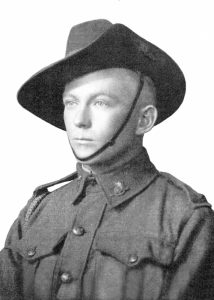
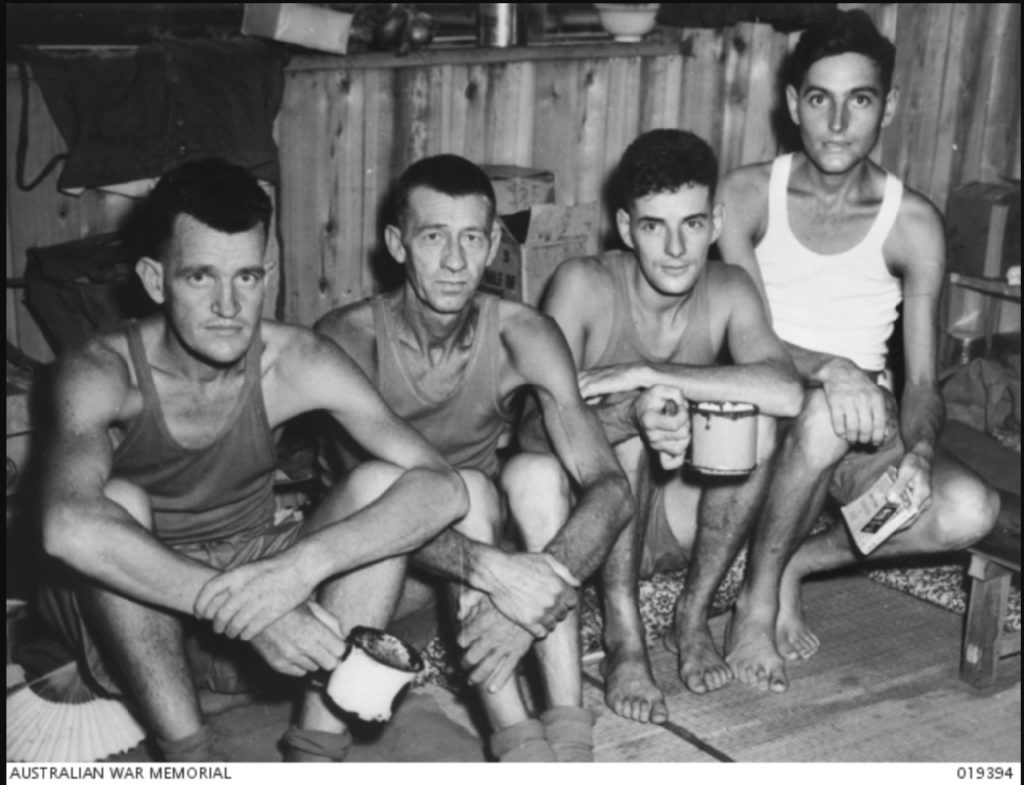
Lance park on left.
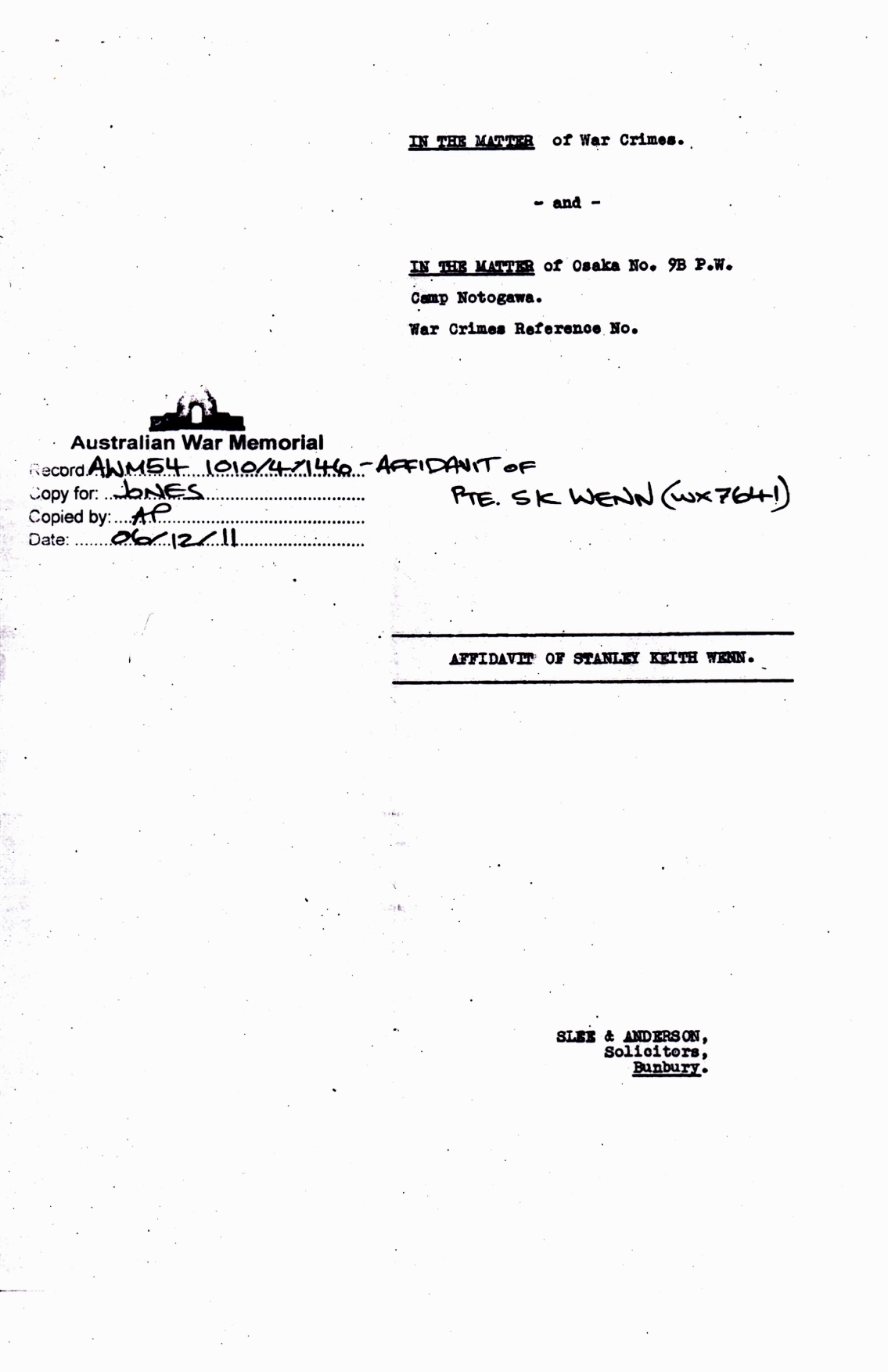
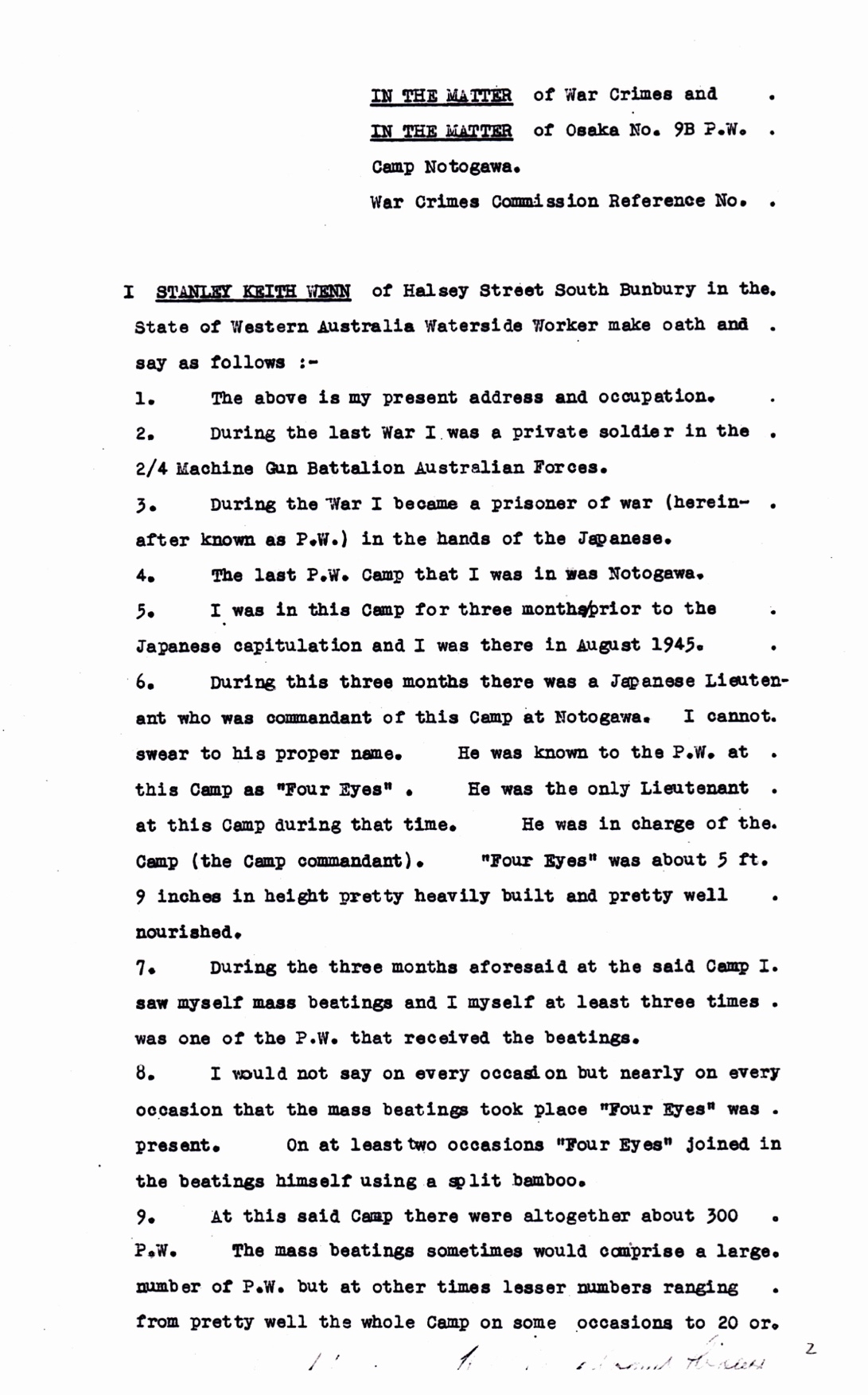
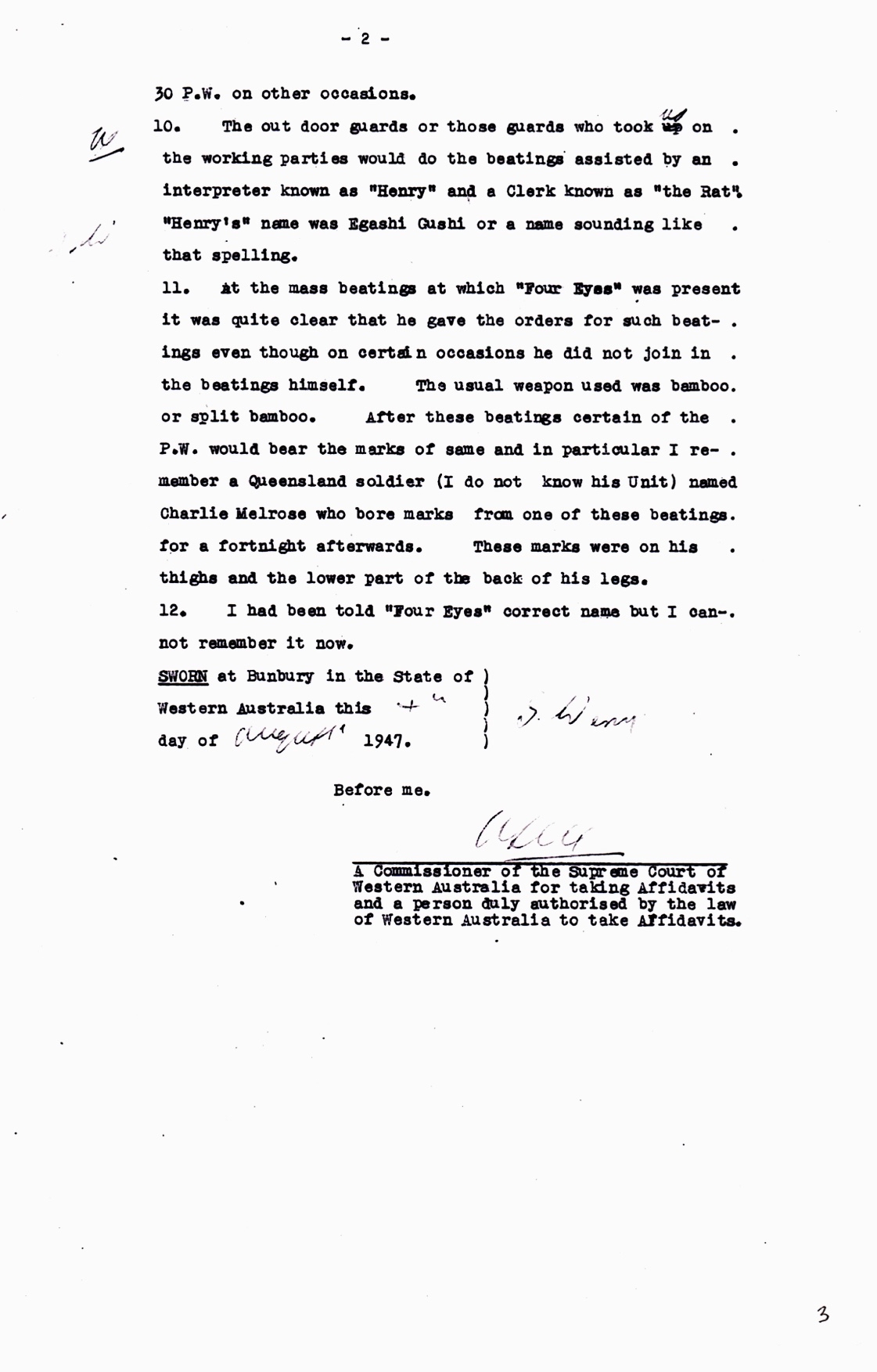
You can read a further description of Notogawa
Please read a transcript of the War Trials
In addition to a starvation diet it is a miracle there were POW no deaths and further, there was no retribution by POWs finally freed.
One cant help wondering what sort of person or persons, either military or civilian could undertake such brutality and spitefulness and consider it part of their role in life.
Also realise this takes place during the final three months of the war, the Japanese (military at least) were aware Japan was losing the war.
-
the locals stole the food dropped by B52 Bombers
-
the Japanese stole Red Cross supples from POWs
-
they were beaten in groups unmercilessly almost on a daily basis
-
were forced to do physical exercises every night after working excessively long hours standing in water all day.
-
several reported cases of punishment when Japanese pushed bamboo sticks up the nose of POWs over a period several hours.
-
Forced POWs hold buckets of water over their head until overcome with exhaustion after which they were further abused and beaten.
